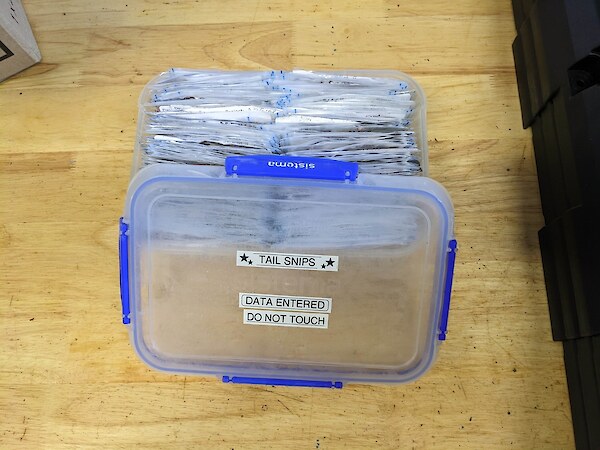DNA unravelling rat populations
This story was taken from our 2023/24 impact report.
Genetic sequencing data of the last remaining rats on the Miramar Peninsula helps us understand the local rat population, and gives us a snapshot into the effectiveness of our biosecurity efforts.
 Our container of rat tail snips for DNA testingThis genomic study, the first of its kind in a New Zealand elimination project, aimed to uncover the genetic relationships among the last remaining rats on the Miramar Peninsula. By mapping their genes, we are able to distinguish between local rat survivors and new invaders, making our biosecurity efforts more targeted and efficient.
Our container of rat tail snips for DNA testingThis genomic study, the first of its kind in a New Zealand elimination project, aimed to uncover the genetic relationships among the last remaining rats on the Miramar Peninsula. By mapping their genes, we are able to distinguish between local rat survivors and new invaders, making our biosecurity efforts more targeted and efficient.
What we did
This was a genomic study, which means it explored the genes and DNA of a plant or animal. From mid-2022 to late 2023, we caught the last ship rats on the peninsula. We collected a short piece of each rat’s tail and sent these to Andrew Veale at Manaaki Whenua Landcare Research. The 74 samples gave 30,000 genetic markers, which helped Andrew and the team create a detailed map of the population.
What we found
Their work showed two distinct groups – rats on Miramar Peninsula were genetically different from those in Rongotai and Lyall Bay. We have a buffer system of traps, cameras and bait to prevent rats returning to the Peninsula. Looking at a genetic level showed that our system worked. The final ship rats we caught during our elimination were Miramar rats: they hadn’t snuck in from other areas.
What it means for our project
We now know what a ‘Miramar rat’ looks like, genetically. When we catch rats on the peninsula in the future, we can compare its genes to our existing data to learn if it was an invader or had avoided us all along. In the past we’d have to guess where rats came from; now we know. As we move across the city, we’ll build a genetic map of rats from different areas.
This study also confirmed what we know about rat behaviour. Normally, closely-related rats stay close to each other. When rat populations are incredibly low, individuals will travel far searching for mates. This means when we find a lone rat, we need a wide buffer to catch other individuals that could be up to 2km away.
We’ll use this data to help refine how we work. This will be especially helpful as we move into later phases of the project, which cover large and challenging areas. The more we understand rat populations, the quicker, smarter, and more cost-effective our path to a predator-free city will become.
Posted: 21 January 2025
